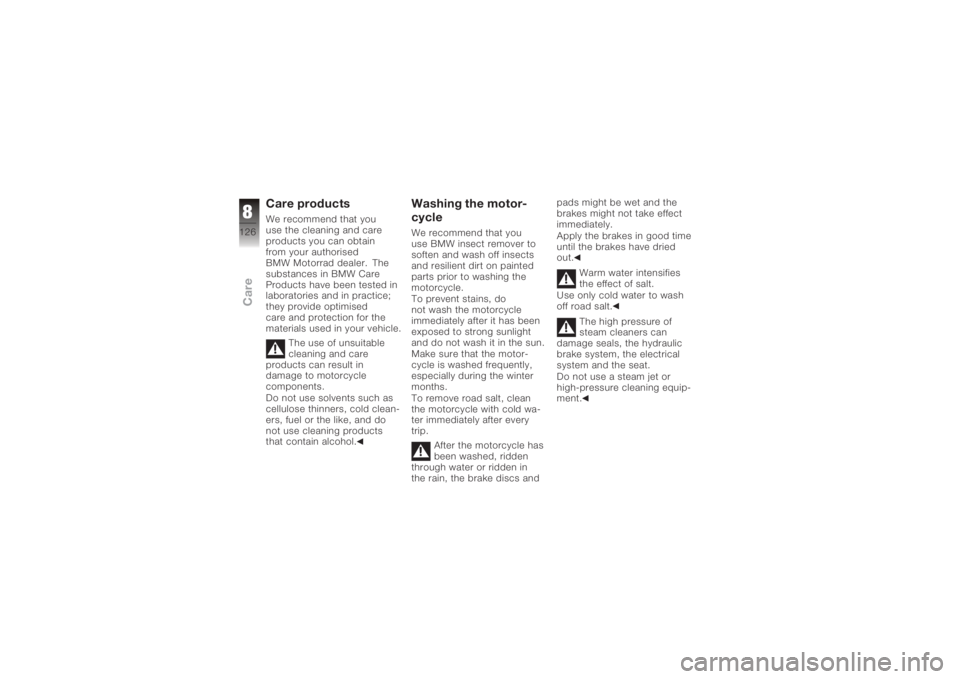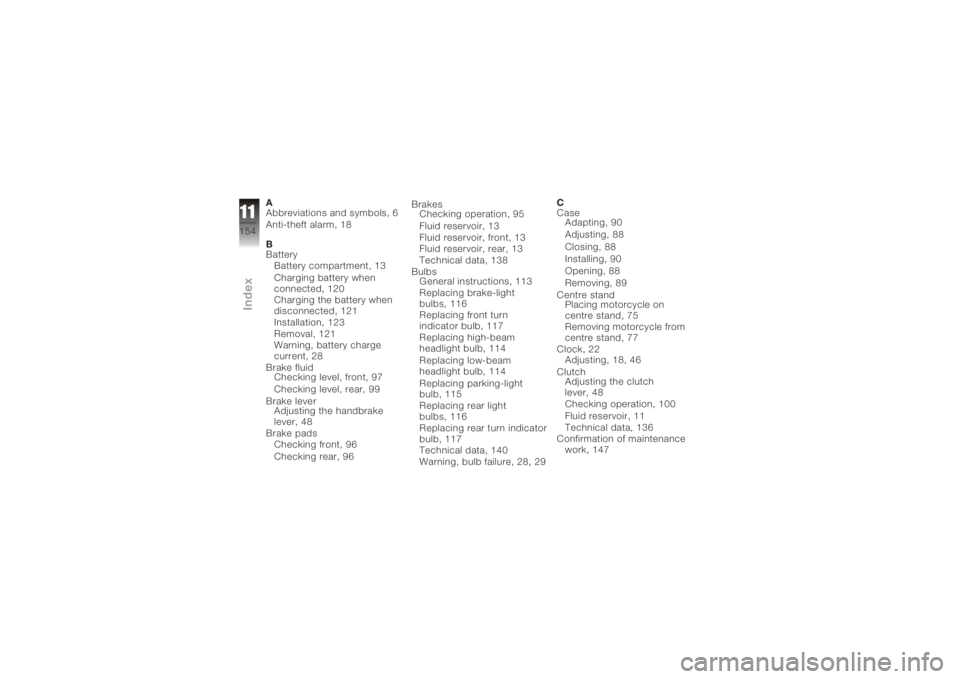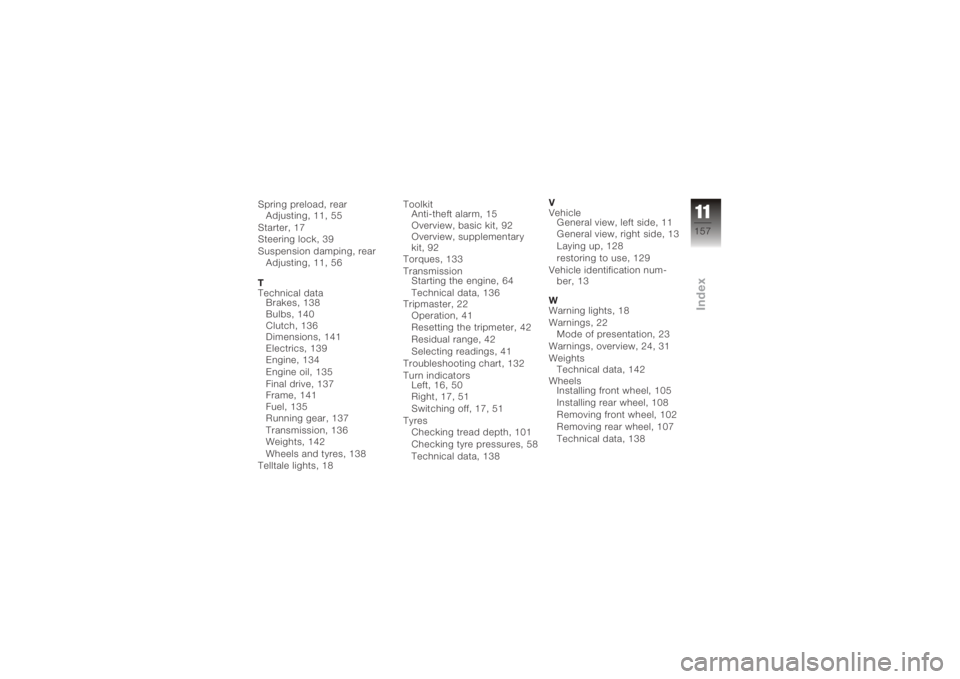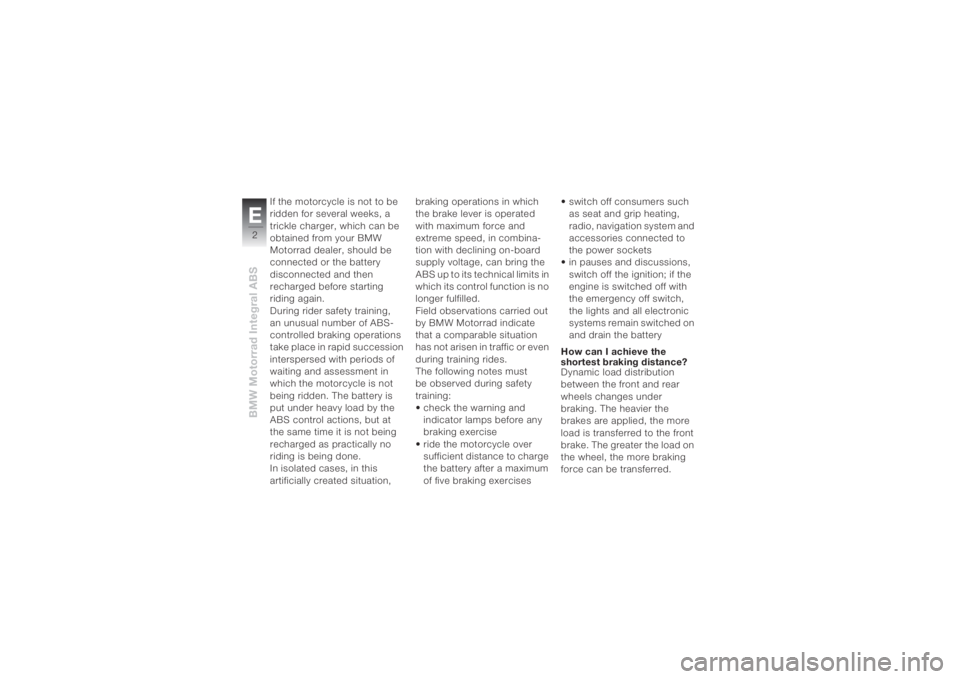Page 118 of 165
Pull the bulb housing for-
ward to remove it and tilt it
slightly down.
Remove bulb holder2from
the headlight housing by
turning it counter-clockwise. Remove bulb
3from the
bulb holder.
Installation of the bulb is the
reverse of the removal pro-
cedure.
Use a clean, dry cloth to
hold the new bulb. The headlight cable
could catch in the
steering if it is not routed
correctly.
Use the appropriate retaining
clips to secure electric wires
at the back of the headlight.
Push the bulb housing into
mounts 4on the frame and
install the securing screws.
Replacing the brake light
and rear light bulbs
If it is not standing firmly,
the motorcycle could
7116zMaintenance
Page 119 of 165
topple in the course of the
operations described below.
Always make sure that the
motorcycle is stable and
firmly supported.Make sure the ground is
level and firm and place the
motorcycle on its stand.
Removing the seat ( 51)
Switch off the ignition.
Remove screw 1. Pull the bulb housing to the
rear until it is clear of hold-
ers
2.
Turn bulb holder 3counter-
clockwise to remove it from
the bulb housing. Press the bulb into
its socket and turn it
counter-clockwise to
remove.
Installation of the brake light
and rear light bulbs is the
reverse of the removal pro-
cedure.
Use a clean, dry cloth to
hold the new bulb.
Replacing turn indicator
bulbs, front/rear
If it is not standing firmly,
the motorcycle could
topple in the course of the
operations described below.
Always make sure that the
motorcycle is stable and
firmly supported.
Make sure the ground is
level and firm and place the
motorcycle on its stand.
Switch off the ignition.
7117zMaintenance
Page 128 of 165

Care productsWe recommend that you
use the cleaning and care
products you can obtain
from your authorised
BMW Motorrad dealer. The
substances in BMW Care
Products have been tested in
laboratories and in practice;
they provide optimised
care and protection for the
materials used in your vehicle.The use of unsuitable
cleaning and care
products can result in
damage to motorcycle
components.
Do not use solvents such as
cellulose thinners, cold clean-
ers, fuel or the like, and do
not use cleaning products
that contain alcohol.
Washing the motor-
cycleWe recommend that you
use BMW insect remover to
soften and wash off insects
and resilient dirt on painted
parts prior to washing the
motorcycle.
To prevent stains, do
not wash the motorcycle
immediately after it has been
exposed to strong sunlight
and do not wash it in the sun.
Make sure that the motor-
cycle is washed frequently,
especially during the winter
months.
To remove road salt, clean
the motorcycle with cold wa-
ter immediately after every
trip.
After the motorcycle has
been washed, ridden
through water or ridden in
the rain, the brake discs and pads might be wet and the
brakes might not take effect
immediately.
Apply the brakes in good time
until the brakes have dried
out.
Warm water intensifies
the effect of salt.
Use only cold water to wash
off road salt.
The high pressure of
steam cleaners can
damage seals, the hydraulic
brake system, the electrical
system and the seat.
Do not use a steam jet or
high-pressure cleaning equip-
ment.
8126zCare
Page 142 of 165
Lighting
High-beam headlight bulb, standard designa-
tionH7 halogen bulb
High-beam headlight bulb, voltage 12 V
High-beam headlight bulb, power 55 W
Low-beam headlight bulb, standard designa-
tion H7 halogen bulb
Low-beam headlight bulb, voltage 12 V
Low-beam headlight bulb, power 55 W
Parking light bulb, standard designation W5W
Parking light bulb, voltage 12 V
Parking light bulb, power 5 W
Tail light / brake light bulb, standard designa-
tion P21W
Tail light / brake light bulb, voltage 12 V
Parking light bulb, power 5 W
Front flashing turn indicator bulbs, standard
designation R10W
Front flashing turn indicator bulbs, voltage 12 V
Front flashing turn indicator bulbs, power 10 W
9140zTechnical data
Page 156 of 165

A
Abbreviations and symbols, 6
Anti-theft alarm, 18
B
BatteryBattery compartment, 13
Charging battery when
connected, 120
Charging the battery when
disconnected, 121
Installation, 123
Removal, 121
Warning, battery charge
current, 28
Brake fluid Checking level, front, 97
Checking level, rear, 99
Brake lever Adjusting the handbrake
lever, 48
Brake pads Checking front, 96
Checking rear, 96 Brakes
Checking operation, 95
Fluid reservoir, 13
Fluid reservoir, front, 13
Fluid reservoir, rear, 13
Technical data, 138
Bulbs General instructions, 113
Replacing brake-light
bulbs, 116
Replacing front turn
indicator bulb, 117
Replacing high-beam
headlight bulb, 114
Replacing low-beam
headlight bulb, 114
Replacing parking-light
bulb, 115
Replacing rear light
bulbs, 116
Replacing rear turn indicator
bulb, 117
Technical data, 140
Warning, bulb failure, 28, 29 C
Case
Adapting, 90
Adjusting, 88
Closing, 88
Installing, 90
Opening, 88
Removing, 89
Centre stand Placing motorcycle on
centre stand, 75
Removing motorcycle from
centre stand, 77
Clock, 22 Adjusting, 18, 46
Clutch Adjusting the clutch
lever, 48
Checking operation, 100
Fluid reservoir, 11
Technical data, 136
Confirmation of maintenance work, 147
11154zIndex
Page 159 of 165

Spring preload, rearAdjusting, 11, 55
Starter, 17
Steering lock, 39
Suspension damping, rear Adjusting, 11, 56
T
Technical data Brakes, 138
Bulbs, 140
Clutch, 136
Dimensions, 141
Electrics, 139
Engine, 134
Engine oil, 135
Final drive, 137
Frame, 141
Fuel, 135
Running gear, 137
Transmission, 136
Weights, 142
Wheels and tyres, 138
Telltale lights, 18 Toolkit
Anti-theft alarm, 15
Overview, basic kit, 92
Overview, supplementary
kit, 92
Torques, 133
Transmission Starting the engine, 64
Technical data, 136
Tripmaster, 22 Operation, 41
Resetting the tripmeter, 42
Residual range, 42
Selecting readings, 41
Troubleshooting chart, 132
Turn indicators Left, 16, 50
Right, 17, 51
Switching off, 17, 51
Tyres Checking tread depth, 101
Checking tyre pressures, 58
Technical data, 138 V
Vehicle
General view, left side, 11
General view, right side, 13
Laying up, 128
restoring to use, 129
Vehicle identification num- ber, 13
W
Warning lights, 18
Warnings, 22 Mode of presentation, 23
Warnings, overview, 24, 31
Weights Technical data, 142
Wheels Installing front wheel, 105
Installing rear wheel, 108
Removing front wheel, 102
Removing rear wheel, 107
Technical data, 138
11157zIndex
Page 163 of 165

BMW Motorrad Integral ABSE2
If the motorcycle is not to be
ridden for several weeks, a
trickle charger, which can be
obtained from your BMW
Motorrad dealer, should be
connected or the battery
disconnected and then
recharged before starting
riding again.
During rider safety training,
an unusual number of ABS-
controlled braking operations
take place in rapid succession
interspersed with periods of
waiting and assessment in
which the motorcycle is not
being ridden. The battery is
put under heavy load by the
ABS control actions, but at
the same time it is not being
recharged as practically no
riding is being done.
In isolated cases, in this
artificially created situation, braking operations in which
the brake lever is operated
with maximum force and
extreme speed, in combina-
tion with declining on-board
supply voltage, can bring the
ABS up to its technical limits in
which its control function is no
longer fulfilled.
Field observations carried out
by BMW Motorrad indicate
that a comparable situation
has not arisen in traffic or even
during training rides.
The following notes must
be observed during safety
training:
• check the warning and
indicator lamps before any
braking exercise
• ride the motorcycle over
sufficient distance to charge
the battery after a maximum
of five braking exercises• switch off consumers such
as seat and grip heating,
radio, navigation system and
accessories connected to
the power sockets
• in pauses and discussions,
switch off the ignition; if the
engine is switched off with
the emergency off switch,
the lights and all electronic
systems remain switched on
and drain the battery
How can I achieve the
shortest braking distance?
Dynamic load distribution
between the front and rear
wheels changes under
braking. The heavier the
brakes are applied, the more
load is transferred to the front
brake. The greater the load on
the wheel, the more braking
force can be transferred.Info_I_ABS_en_xx.fm Seite 2 Dienstag, 19. Juli 2005 2:48 14
Page:
< prev 1-8 9-16 17-24